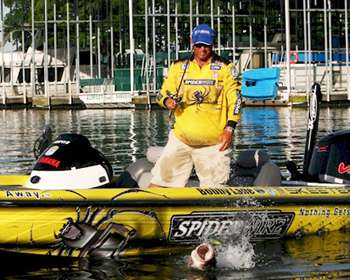
What does a Florida angler know about big swimbaits?
Bobby Lane, Floridian and 2008 Rookie of the Year in the Bassmaster Elite Series, may not have developed his swimbait knowledge over the long term, but at the 2009 Elite Series event on Kentucky Lake he showed that he's a quick study. Lane used a Berkley Power Mullet — a weighted soft plastic swimbait — to lead the competition wire-to-wire and claim his first major win.
While it may not be the preferred presentation on the shallow grassy bowls near his Sunshine State home, Lane reveals that it's one of his favorite tactics on current-run reservoirs throughout the mid-South, particularly when the fish are out on offshore humps, shoals and river ledges.
"On any of the river impoundments that have current, you want to throw the weighted swimbait," he says. "The first reason I used it at Kentucky Lake was because the current generation there really moved a lot of water," he says. "The regular, unweighted swimbaits are slow-moving baits made for clearer water. I used the big weighted swimbait at Kentucky Lake because it got down to the bottom fast and stayed there."
Once the bait is on the bottom, the heavy currents that cause bass to gang up and compel them to strike won't hinder the lure's action, either. The heavy internal weight and the swimbait's action tail mean that the retrieve creates the lifelike action. The faster you reel, the more it moves.
"There are a whole lot of weighted swimbaits out there," he adds. "I used the Power Mullet simply because it has an awesome 6/0 hook that is really sharp. If the bass bit, I got it into the boat. It's a very heavy bait so you can throw it on 65-pound braid or 25-pound fluorocarbon and not have a problem with it."
At Kentucky Lake, Lane knew where the fish were, but had to adjust slightly each day. "You generally want to make a long cast with a swimbait so you can cover a lot of water," he explains. "When those fish get on certain spots, they tend to move around a little bit, so you want to fancast the whole area."
While the heavy weight and the big hook have their advantages, they also give the fish leverage to throw the bait if they get a good head shake going. Therefore, Lane recommends tightening your drag.
"Crank that drag down all the way," he says. "When one of those fish bites, you want to hook up and bring it in as fast as you can. You really don't want the fish to jump if you can help it. It's a scary moment when that happens."
His tools of the trade are a 7-foot, 6-inch heavy action rod paired with an Abu Garcia Toro reel.
"At Kentucky I was using 17- and 20-pound fluorocarbon, but I'll throw it on 65-pound braid, too," he says. "The reason I didn't there is because of the mussels. The fluorocarbon still doesn't have any stretch, but it won't cut as easily."





